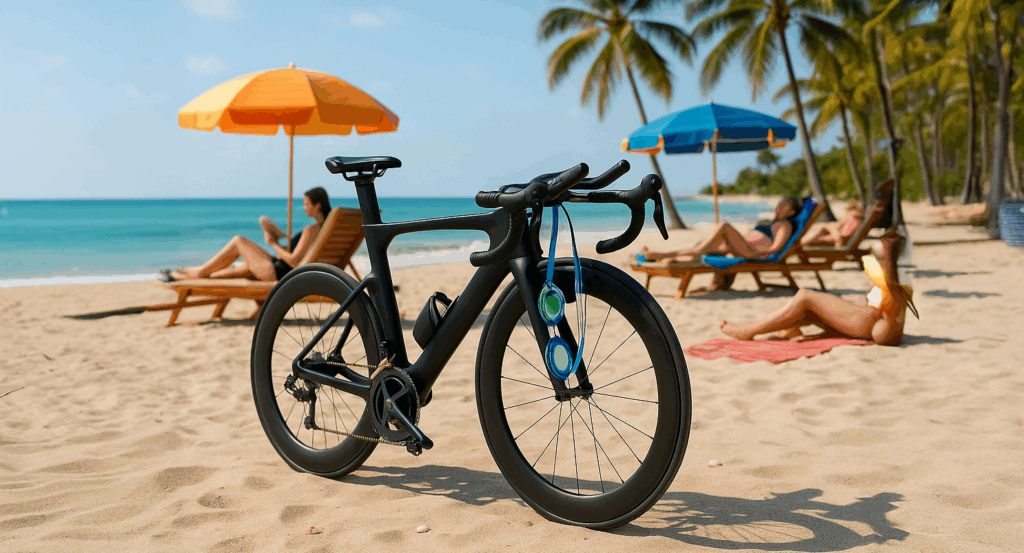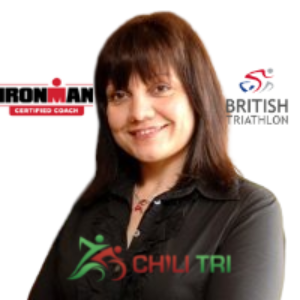By Coach Karen Parnell MSc, Triathlon & Multisport Coach
The off-season is a gift. Used well, it protects your long-term progress, tidies up niggles, hardens your strengths (swimming and cycling!), and lets you stroll into base training feeling fresh, not rusty.
Below are coach-tested, evidence-backed do’s and don’ts tailored to Aquabike athletes — followed by a practical way to ease back into structured training with one of my Aquabike Maintenance Plans, available on Final Surge and TrainingPeaks.
Listen to the audio version of this article:

Do’s
1. Keep a little intensity to protect your engine.
Endurance adaptations fade fastest when training stops entirely. Small amounts of high-intensity work maintain V̇O₂max and performance surprisingly well.
Classic work shows V̇O₂max can be maintained for up to 15 weeks with only two weekly high-intensity sessions, provided intensity stays high even if frequency or volume drop (Mujika & Padilla, 2000).
Tip: Two short interval sessions a week — one swim, one bike — are enough to hold onto your engine.
2. Lift (properly) in the off-season.
Heavy strength training (2 sessions per week) improves cycling economy, time-trial power, and upper-body swim strength. Meta-analyses across endurance sports echo these benefits (Rønnestad et al., 2015; Crowley et al., 2017).
Tip: Focus on compound lifts (squat, deadlift, pull-ups, rows) and progressive load — this is the time to build durable power.
Get your FREE Strength Training Guide
3. Work on swim mechanics and efficiency.
Aquabike swim performance hinges on both energy systems and biomechanics. Prioritise efficiency: long strokes, reduced drag, and stable timing. Studies link front-crawl speed to stroke length and smooth coordination (Seifert et al., 2004).
Tip: Keep technique work short and focused — this is your chance to rewire your stroke without race pressure.
Get your FREE Swim Technique E-Book
4. Sleep and fuel like an athlete, even when volume dips.
Sleep loss impairs recovery and decision-making, while good sleep improves learning and performance (Fullagar et al., 2015).
Maintain adequate protein (~1.6–2.0 g/kg/day) across the day to support muscle retention and repair (Thomas et al., 2016; Jäger et al., 2017).
Tip: Eat well, hydrate, and treat rest as part of training.
5. Add variety and fun.
Try hiking, gravel rides, or yoga. Variety prevents mental burnout and maintains motivation — key for long-term consistency (Isoard-Gautheur et al., 2013).
Tip: The goal is active recovery, not complete inactivity.
Don’ts
1. Don’t “park the bike” or “drop the pool” completely.
Even a two-week total break can cause measurable declines in endurance capacity and plasma volume (Neufer, 1989; Mujika & Padilla, 2000).
Tip: Keep your body moving — light aerobic sessions are enough to retain base fitness.
Get your FREE 31 Structured Indoor Bike Sessions
2. Don’t cut all intensity.
If you reduce frequency and volume, keep some quality. Maintaining intensity while trimming volume is the key to effective tapering and performance retention (Neary et al., 2003).
Tip: keep one short higher-intensity swim and one short higher-intensity bike each week while overall volume is reduced.
3. Don’t overdo paddles or “shoulder-taxing” toys.
Swimmer’s shoulder risk increases when fatigue causes technique breakdown (Heinlein & Cosgarea, 2010).
Tip: Use paddles sparingly and with purpose, not as a strength substitute. Consider using a technique paddle instead of a power paddle such at the OTION paddle.
4. Don’t under-fuel.
Even in the off-season, low energy availability harms recovery, hormones, and adaptation (Mountjoy et al., 2018).
Tip: Match intake to your training load and avoid unnecessary restriction.
Get your FREE Athlete Recipe Books
Getting Back to Training: The Maintenance Phase
When you’re ready to move from recovery to structured work again, step into a Maintenance Plan — designed to preserve your aerobic base and strength while rebuilding consistency safely.
I’ve created specific Aquabike Maintenance Plans on Final Surge and TrainingPeaks to help you do just that. These plans balance swim and bike sessions with targeted strength training and recovery — perfect for bridging the gap between the off-season and your next performance block.
Final Thought
The off-season isn’t about stopping. It’s about sharpening the saw — taking time to restore, reflect, and rebuild smartly. Do that, and you’ll start your next season not just refreshed, but ready to fly.

Karen Parnell is a Level 3 British Triathlon and IRONMAN Certified Coach, TrainingPeaks Level 2 Coach, and founder of ChiliTri. With over 15 years’ experience coaching triathletes, Aquabike specialists, and endurance athletes worldwide, she blends science-based programming with real-world practicality.
Karen recently completed her Master’s degree in Sports Performance Coaching, focusing on evidence-led approaches to multisport performance. Her training plans are available on Final Surge and TrainingPeaks, helping athletes of all levels build strength, speed, and confidence — in the water and on the bike.
References
Crowley, E., Harrison, A. J., & Lyons, M. (2017). The impact of resistance training on swimming performance: a systematic review. Sports Medicine, 47(11), 2285–2307.
Fullagar, H. H. K., Skorski, S., Duffield, R., Hammes, D., Coutts, A. J., & Meyer, T. (2015). Sleep and athletic performance: the effects of sleep loss on exercise performance, and physiological and cognitive responses to exercise. Sports
Medicine, 45(2), 161–186.
Heinlein, S. A., & Cosgarea, A. J. (2010). Biomechanical considerations in the competitive swimmer’s shoulder. Sports Health, 2(6), 519–525.
Isoard-Gautheur, S., Guillet-Descas, E., & Duda, J. L. (2013). How to achieve in elite training centres without burning out: a motivational perspective on high-level youth athletes. Psychology of Sport and Exercise, 14(1), 72–83.
Jäger R, Kerksick CM, Campbell BI, Cribb PJ, Wells SD, Skwiat TM, Purpura M, Ziegenfuss TN, Ferrando AA, Arent SM, Smith-Ryan AE, Stout JR, Arciero PJ, Ormsbee MJ, Taylor LW, Wilborn CD, Kalman DS, Kreider RB, Willoughby DS, Hoffman JR, Krzykowski JL, Antonio J. (2017). International Society of Sports Nutrition Position Stand: protein and exercise. Journal of the International Society of Sports Nutrition, 14, 20.
Mountjoy M, Sundgot-Borgen JK, Burke LM, Ackerman KE, Blauwet C, Constantini N, Lebrun C, Lundy B, Melin AK, Meyer NL, Sherman RT, Tenforde AS, Klungland Torstveit M, Budgett R. (2018) IOC consensus statement on relative energy deficiency in sport (RED-S): 2018 update. British Journal of Sports Medicine, 52(11), 687–697.
Mujika, I., & Padilla, S. (2000). Detraining: loss of training-induced physiological and performance adaptations. Part I. Sports Medicine, 30(2), 79–87.
Neary, J. P., Martin, T. P., & Quinney, H. A. (2003). Effects of taper on endurance cycling capacity and single muscle fiber properties. Medicine & Science in Sports & Exercise, 35(11), 1875–1881.
Neufer, P. D. (1989). The effect of detraining and reduced training on the physiological adaptations to aerobic exercise training. Sports Medicine, 8(5), 302–320.
Rønnestad, B. R., Hansen, J., & Mujika, I. (2015). Strength training improves performance and pedaling characteristics in elite cyclists. Scandinavian Journal of Medicine & Science in Sports, 25(1), e89–e98.
Seifert, L., Chollet, D., & Bardy, B. G. (2004). Effect of swimming velocity on arm coordination in the front crawl: a dynamic analysis. Journal of Sports Sciences, 22(7), 651–660.
Thomas, D. T., Erdman, K. A., & Burke, L. M. (2016). Nutrition and athletic performance. Medicine & Science in Sports & Exercise, 48(3), 543–568.
